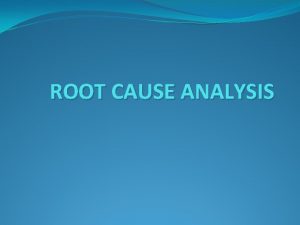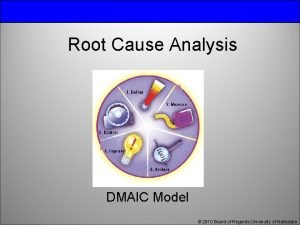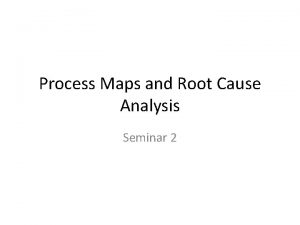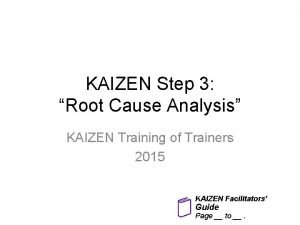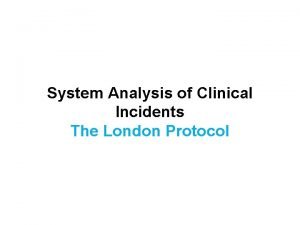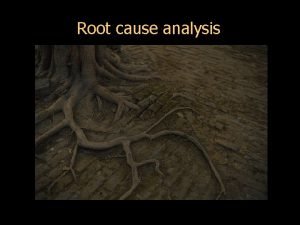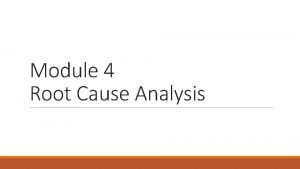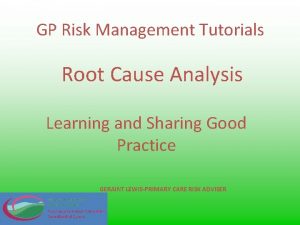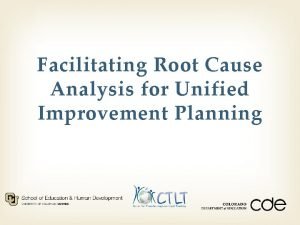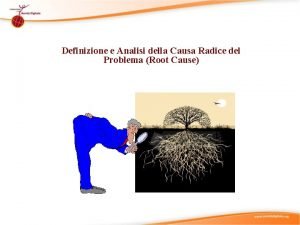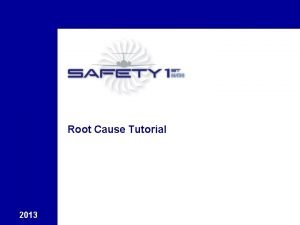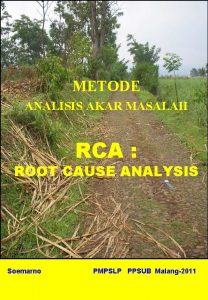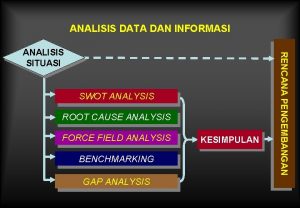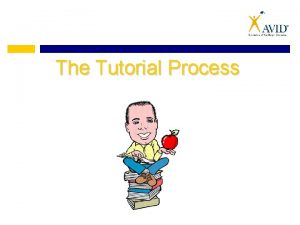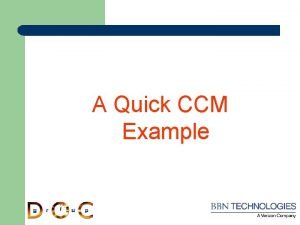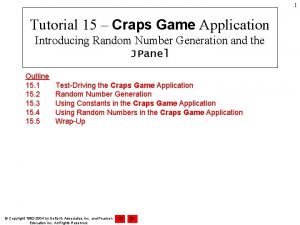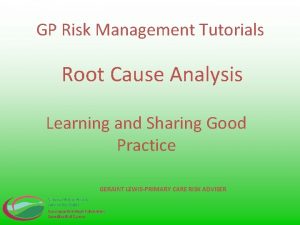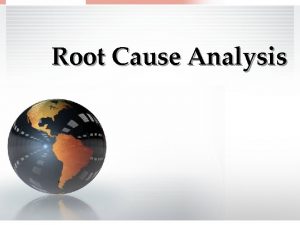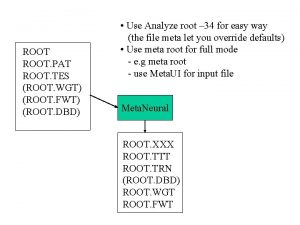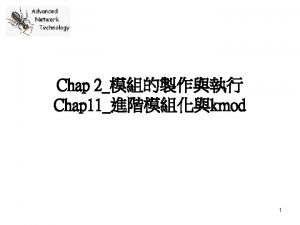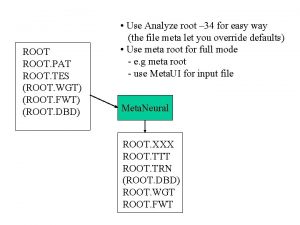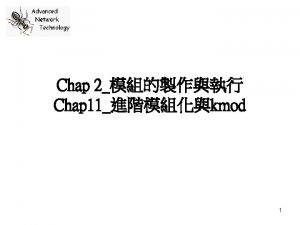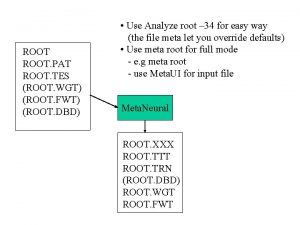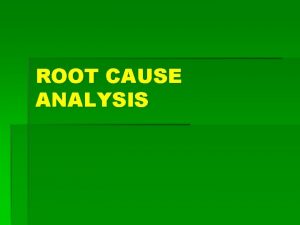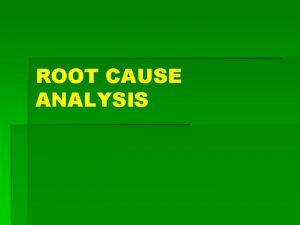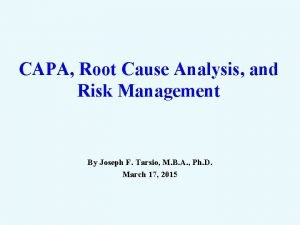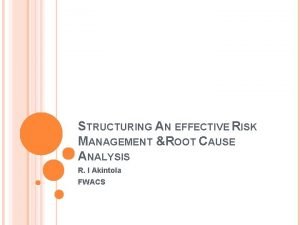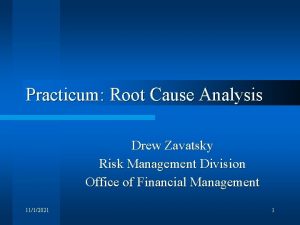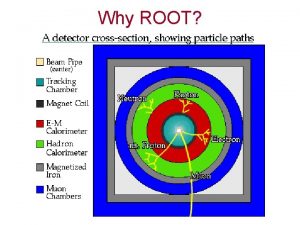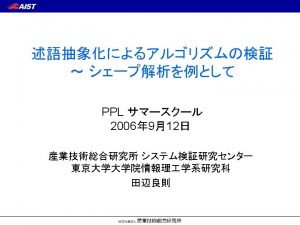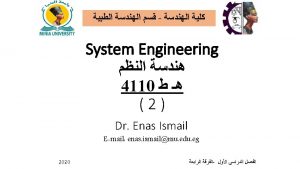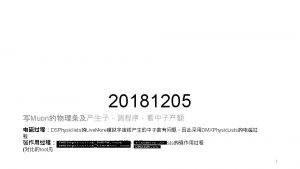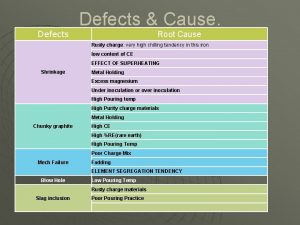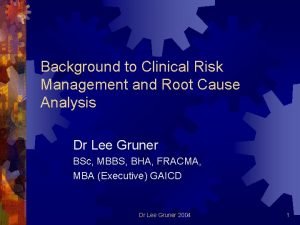GP Risk Management Tutorials Root Cause Analysis Learning







































- Slides: 39

GP Risk Management Tutorials Root Cause Analysis Learning and Sharing Good Practice GERAINT LEWIS-PRIMARY CARE RISK ADVISER

Objectives • To increase your understanding of theory & application of (RCA) • To gain insight into the skills required to undertake effective RCA • To be able to undertake RCA using the tools and techniques demonstrated to investigate an incident

Root Cause Analysis and patient safety, Why is it important ? Today’s health-care context is highly complex. Care is often delivered in a pressurized and fast-moving environment, involving a vast array of technology and, daily, many individual decisions and judgements by health-care professional staff. In such circumstances things can and do go wrong. Sometimes unintentional harm comes to a patient during a clinical procedure or as a result of a clinical decision. Errors in the process of care can result in injury. Sometimes the harm that patients experience is serious and sometimes people die. (World Health Organisation-World Alliance for Patient Safety)

The Patient Safety Agenda Organisation with a Memory (June 2000) Even after a decision has been taken to conduct some form of inquiry or investigation, there is often little by way of consistent support or expertise available to NHS organisations or to inquiry teams in the conduct of the process Building a Safer NHS for Patients (2004) Described the necessary steps to set up the new national system. These include building expertise in the NHS in root cause analysis 7 Steps to Patient Safety (2004) Guidance to local organisations to ensure that the investigation team they create is proficient in RCA by providing both online and face-to-face training

Where does RCA fit in? • RCA is part of a Safety and Quality process. • It sits alongside incident reporting, patient safety education and training and feeds into an organisation’s Risk Management Strategy. • It supports the organization to learn and develop

What is Root Cause Analysis? What is a Root Cause? • The root or fundamental issue, is the earliest point at which action could have been taken that would have reduced the chance of the incident happening. What is Root Cause Analysis? • Structured process using recognised analytical methods • Enables you to ask the questions “How” and “Why” in an objective way to reveal all the causal factors that have led to a patient safety incident. • Should be used to prevent similar incidents happening again, not to apply blame.

Root Cause Analysis • • To be thorough RCA must involve a complete review of all possible antecedent events and actions Look at human behaviour Look at processes and systems Consider all the key players Need to understand what went wrong, how it went wrong and how it could be done differently

Root Cause Analysis To be credible a root cause analysis must: • Be closely supported by the leadership of the organisation • Involve those closely associated with the processes and systems and the outcomes. • Be applied consistently and transparently according to organisational policy/procedure • Include consideration of relevant literature ie what is best practice? What processes and systems function elsewhere?

Root Cause Analysis To be effective a root cause analysis must : • Include development of actions aimed at improving processes and systems; • Ensure there is agreement as to how those improvements will be monitored and evaluated • Be well documented (including all the activity from the point of identification to the process of evaluation). • Engage those involved in the original incident • Gain the support of those who can make the changes

Human Error is Inevitable – – Two approaches to the problem of human fallibility exist: the person and the system approaches The person approach focuses on the errors of individuals, blaming them forgetfulness, inattention, or moral weakness The system approach concentrates on the conditions under which individuals work and tries to build defences to avert errors or mitigate their effects High reliability organisations which have less than their fair share of accidents recognise that human variability is a force to harness in averting errors, but they work hard to focus that variability and are constantly preoccupied with the possibility of failure

Two Views On Human Error • • Old View Human error is a cause of accidents To explain failure, you must seek human failure Find people’s incorrect assessments, wrong decisions, bad judgments Get rid of ‘bad apples’ replace with new personnel New View • Error is a symptom of deeper trouble • To explain failure, look for the system failure • Explore how actions and assessments made sense at time • Replacing people leaves problems in place

Error Types Violations involve deliberate deviations from some regulated code of practice or procedure, Reason (1993). They occur because people intentionally break the rules. Short cuts Good reason Familiar situation-wrong package deliberate deviations from a protocol or code of conduct Persons training insufficient to cope These errors occur when people do not have appropriate, or sufficient, information upon which to base their decisions or plans Driving to work on your day off! Autopilot! Professor James Reason ‘Error Types’

Group Work 1 Can you think of one instance where you have made: 1. A Violation 2. A Mistake 3. A lapse 4. A slip

n Human errors occur because of: n n n n Inattention Memory lapse Failure to communicate Poorly designed equipment Exhaustion Ignorance Noisy working conditions A number of other personal and environmental factors

Systems approach • “The systems approach is not about changing the human condition but rather the conditions under which humans work”. J. T Reason, 2001

Process for RCAs • STEP 1: Agree facts of event • STEP 2: Establish causality • STEP 3: Produce Action Plans

CASE EXAMPLE: The Jack and Jill story

Step 1 Identify what happened antecedents • • • How far back do you go? Who do you involve/question? How much detail do you need? Where all your sources of information? How much time do you have?

RCA - Gathering the information • • • Incident report Health records Policies Equipment& maintenance records Audit data • Photographs • Staff rotas • Risk assessments • Training records • Witness accounts • Interviews

RCA -Telling the story : Helpful tools Timeline: Tracks chronological chain of events. Allows the team to identify information gaps as well as problems in the process of care delivery. Time person grid: Maps /tracks the movements of people involved before, during and after incident. Flowchart: Depicts events sequence in simple, easy to read format.

Timeline Time Line Timetable of events 06. 30 Jack and Jill wake up 06. 50 No water in tap 07. 00 Jack encourages Jill to get out of bed 07. 10 Jill finally gets up 07. 20 Pail found 07. 30 Jack and Jill proceed to walk up the hill 07. 50 Pail filled too full 08. 00 Handle on pail breaks and Jack stumbles and bangs his head 08. 01 Jill also stumbles and falls 08. 30 Jack and Jill found by neighbour walking the dog 08. 40 999 call to local ambulance service 09. 10 Ambulance arrives 09. 25 Local accident and emergency department closed due to broken water main 09. 35 Jack walks off 09. 45 Local pharmacy won’t provide vinegar and brown paper 10. 30 Jack goes home and goes to bed with a bottle of whisky and a plastic bag 16. 00 Jack Found dead in bed-aspirated on vomit.

Tabular timeline Date and Time of Event 6 May, 2008 -08. 40 6 May 2008 -09. 25 Event 999 call received from 22 Bucket Lane-patient 1 has broken his crown and patient 2 has had a bad fall Paramedic crew arrive at the area but cannot locate patients. Patients finally located and taken to local A and E dept which is closed. Supplementary Information Very distressed patients, one with severe head trauma and patient 2 (partner) has cuts and bruises to legs, chest and a suspected twisted ankle. Local A+E closed due to a broken water main. Asked if patients wanted to go to nearest alternate A+E but patients disappear. Later patient 1 Male found dead in bed aspirated on vomit. Good Practice None Care/Service Delivery Problem Failure to fully assess and document health of patient Ambulance slow, Local A+E shouldn’t have been closed-Disaster recovery plan should have been implemented, Social services should have been informed regarding patient 1

Time-person grid If Jack had made it to A+E!! Staff 10. 05 10. 15 10. 25 Senior Nurse A With patient 1 With patient 3 On break Health care Assistant With patient 1 ? Nurses coffee room Social Worker With patient 1 With patient 2 Dr 1 ? ? On break What were they doing over a 20 minute period in the busy A+E Department

Step 2 - Establish causality • Analysis focuses on systems and processes and the way individuals interact with them, • Analysis starts with apparent or primary causes and progresses to identification of system vulnerabilities (root causes and contributing factors) • Analysis repeatedly digs deeper by asking “why” questions until no additional logical answer can be identified • Analysis identifies changes that could be made in systems and processes to reduce the risk of a similar event occurring

Step 2: Causality • Determine pertinent areas • Focus on pertinent areas • Formulate causal statements

How would you classify the severity of this case? Who would you want/expect to investigate this case? What is the extent of your investigation?

QUALITATIVE RISK ASSESSMENT MATRIX – LEVEL OF RISK (Based on the AS/NZS 4360: 1999 Risk Management Standard)

RCA Techniques 5 Whys Barrier analysis Change analysis Causal factor tree analysis Failure mode and effects analysis Ishikawa diagram, also known as the fishbone diagram or cause and effect diagram • Fault tree analysis • • •

Example of five whys-I’ve just been given a parking ticket! Why ? I have just been given a parking ticket Parked in a 10 minute max parking zone and time expired Why ? Held up in a queue at the local bakery Why ? The till was inoperative Why ? Bakery had forgotten to extend maintenance contract Till had not been serviced by manufacturers Root Cause

Patient Factors Equipment and resource factors Individual Factors Task Factors Working condition factors Team Factors Organizational and strategic factors Communication factors Education and Training factors

NPSA Contributory Factor Framework • • • Patient factors Individual (staff) factors Task factors Communication factors Team and social factors Education and training factors Equipment and resource factors Working conditions factors Organisational & strategic factors

Step 3 The Action Plan

Key principles of solution creation w Design tasks and processes that minimise dependency on short term memory, attention span & avoid fatigue w Simplify task, processes and so on w Standardise processes & equipment w Use tools and checklists wisely w Make it easier to do the right thing!

Process Redesign Solutions Make mistakes impossible – Auto-shut off heating devices – Circuit breakers – Ready-to-administer medications – Write-over protected computer disks – Can you think of other mistake-proofing techniques? Remember redesign means new Risks. Solving a problem in one area may create a new problem in another

SEA/RCA – REPORT FORMAT WHAT HAPPENED? (Including the role of all individuals directly and indirectly involved, the setting for the event, and any impact or potential impact of the event that is relevant to patient care or the conduct of the practice) WHY DID IT HAPPEN? (Including description and discussion of the main and underlying reasons for the event occurring, where this is possible) WHAT HAVE YOU LEARNED? (Reflect on significant event and highlight personal and, if appropriate, team-based learning) WHAT CHANGES WILL YOU MAKE? (What action will be taken, where this is relevant or feasible, ensuring that all relevant individuals are involved, how will you monitor the changes)

Report Preparation • Cause and effect relationships must be clear • Don’t overstate, understate, or emotionalize report. It may show up in court. • Negative descriptors may not be used – “poorly”, “inadequate”, “unsafe”, “unreliable”, and “complacency” among many others

RCA Summary • • • Gather the facts. Determine sequence of events. Identify contributing factors. Select root causes. Develop corrective actions & follow-up plan.

And finally…a good RCA is one that … • Identifies all the contributory causes • Leads to more robust systems and processes • Addresses all key emergent issues not just root causes • Shares effective ways to reduce the chances of similar mishaps recurring elsewhere within or without the organisation and /or shares examples of good practice

FEEDBACK AND QUESTIONS! Thank you for listening!
 Market risk assessment
Market risk assessment Root cause analysis sop
Root cause analysis sop Root cause analysis esempi
Root cause analysis esempi Dmiac
Dmiac Process mapping for root cause analysis
Process mapping for root cause analysis Root cause analysis
Root cause analysis Contoh laporan root cause analysis
Contoh laporan root cause analysis London protocol template
London protocol template Fishbone's menu
Fishbone's menu 4p root cause analysis
4p root cause analysis Root cause analysis tutorial
Root cause analysis tutorial Adverse vs sentinel event
Adverse vs sentinel event Jefferson memorial root cause analysis
Jefferson memorial root cause analysis Rischio clinico slide
Rischio clinico slide Jefferson memorial root cause analysis
Jefferson memorial root cause analysis Root cause analysis
Root cause analysis Root cause analysis definizione
Root cause analysis definizione Jefferson memorial and the 5 whys
Jefferson memorial and the 5 whys Root cause analysis sample
Root cause analysis sample Is the central theme of kaizen
Is the central theme of kaizen Root cause analysis steps
Root cause analysis steps Metode rca
Metode rca Contoh root cause analysis
Contoh root cause analysis Key risk indicators template
Key risk indicators template Risk map risk management
Risk map risk management Cuadro comparativo e-learning b-learning m-learning
Cuadro comparativo e-learning b-learning m-learning Ter thin client
Ter thin client Ultimate cause of behavior
Ultimate cause of behavior Proximate and ultimate behavior examples
Proximate and ultimate behavior examples Imprinting biology examples
Imprinting biology examples One question the tutorial sparked for you
One question the tutorial sparked for you Nitmed tutorials
Nitmed tutorials Macromedia dreamweaver 8 tutorial
Macromedia dreamweaver 8 tutorial Flash dreamweaver templates
Flash dreamweaver templates Web authoring using adobe dreamweaver - selected response
Web authoring using adobe dreamweaver - selected response Ccm tutorials
Ccm tutorials 247 craps
247 craps Xna game tutorial
Xna game tutorial Opti 521
Opti 521 Planbook.com
Planbook.com


